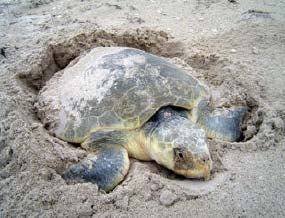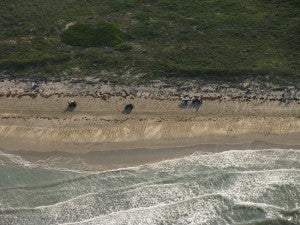
Another Good Summer for Kemp’s Ridley Sea Turtles

Kemp’s ridley sea turtle nesting season is winding down for the summer, and I’m happy to report that nest numbers are still on the rise! While the Kemp’s ridleys still are the world’s most critically endangered sea turtle, they are making a huge come back in recent years.
Until half a century ago, tens of thousands of Kemp’s ridleys would surge onto Mexico’s Gulf of Mexico beaches in a few large nesting events each year to lay their eggs. At the turn of the 20th century, turtle meat and eggs became popular delicacies, causing the turtle’s population to crash. Later, accidental catches in fishing gear kept their population from recovering.
Today, Kemp’s ridleys are rebounding due to protections that government, fishing industry, EDF and other conservation groups helped win. These unprecedented actions included protecting Mexico beaches where the turtles nest, monitoring hatchlings at an incubation site, and establishing the headstart program and a second nesting site in Texas. The initial recovery program spanned from 1978-1988. During this time, over 22,000 eggs were transported from Playa de Rancho Nuevo in Mexico to Padre Island National Seashore in Texas. Once hatched, the turtles were exposed to the Padre Island sand and surf, and then captured and transported to the National Marine Fisheries Service Laboratory in Galveston, Texas, where they were reared in captivity for 9-11 months. This “head-start” program allowed the turtles to grow large enough to be tagged for future recognition and to avoid most natural predators. It was hoped that this exposure would imprint the turtles to the National Seashore so they would return year after year to nest at adulthood.
Our advocacy among others also helped to secure Turtle excluder devices and a seasonal no-trawl zone off Padre Island, Texas, to protect spawning white shrimp and endangered Kemp’s ridley sea turtles during sensitive life stages. These and other measures (including continued safeguards for nesting beaches) have helped Kemp’s ridleys populations begin their recovery.
At Playa de Rancho Nuevo in Mexico, the numbers are up from 700 in 1985 to more than 20,570 nests in 2011. In Texas each summer, the nests are tracked and checked daily. The number of nests have climbed from 1 in 1978 to a high of 199 in 2011 due to extraordinary steps taken to establish a secondary nesting site at Padre Island National Seashore. These unprecedented efforts led by Dr. Donna Shaver and others as part of the Sea Turtle Recovery Project, have restored hope for the fate of the critically endangered species. In Texas, this year’s total stands at 209 nests (with a clutch size of an average of 100 eggs) and continues to follow the 8 years consecutive record breaking trend. Learn more about the about the turtle’s history and conservation efforts taken in recent years to help the Kemps ridleys population recover.
To get day-to-day updates on hatchings off Padres Island, visit the Padre Island NS Division of Sea Turtle Science & Recovery facebook page or click here for 2012 updates from the Sea Turtle Recovery Project.










